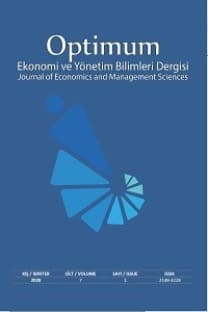Mülkiyet Yoğunlaşmasının Sermaye Yapısı Üzerindeki Etkisi: Türk Bankacılık Sektörü Örneği
Bu çalışmada Borsa İstanbul’da işlem gören bankalardaki mülkiyet yoğunlaşması ile bankaların sermaye yapısı arasındaki ilişkinin belirlenmesi amaçlanmıştır. Bu kapsamda, Borsa İstanbul’a kayıtlı on mevduat bankası 2005-2015 yılları arasında değerlendirmeye alınmış olup, panel veri analizi tekniğinden yararlanılmıştır. Mülkiyet yoğunluğunun belirlenmesinde; en büyük ortağın sermaye payı ve halka açıklık oranları dikkate alınırken, sermaye yapısı değişkenleri olarak ise bankaya özgü oranlar değerlendirmeye alınmıştır. Çalışmanın sonucunda elde edilen bulgular en büyük hissedarın sermaye payı, halka açıklık oranı, aktif karlılığı ve banka büyüklüğünün bankaların sermaye yapısı kararları üzerinde istatistikî olarak anlamlı bir etkiye sahip olduğunu göstermiştir.
Anahtar Kelimeler:
Mülkiyet Yoğunlaşması, Sermaye Yapısı, Mevduat Bankaları, Panel Veri Analizi
Impact of Ownership Concentration on Capital Structures: A Case of Turkish Banking Sector
This study aims to determine the effects of the listed deposit banks’ ownership concentration on capital structures. In this context; ten deposit banks listed on Borsa Istanbul have been evaluated for the period of 2005-2015 and panel data analysis has been used. As the ownership structure variables; major shareholders and free float rate have been used and the ratios particular to banking sector have been analysed as capital structure variables. In conclusion, the findings have shown that major shareholder, free float rate, return on assets and bank size variables have a statistically significant impact on the banks’ capital structures.
___
- Al-Amarneh, A. (2014). Corporate governance, ownership structure and bank performance in Jordan. International Journal of Economics and Finance, 6 (6), 192-202.
- Al-Fayoumi, N. A., & Abuzayed, B. M. (2009). Ownership structure and corporate financing. Applied Financial Economics, 19, 1975-1986.
- Altunbas, Y., Evans, L., & Molyneux. P. (2001). Bank ownership and efficiency. Journal of Money, Credit and Banking, 33 (4), 926-954.
- Brailsford, T. J., Oliver, B. R., & Pua, S. L. (2002). On the relation between ownership structure and capital structure. Journal of Accounting and Finance, 42, 1-26.
- Breusch, T.S., & Pagan, A. R. (1980). The Lagrange multiplier test and its applications to model specification in econometrics. Review of Economic Studies, 47 (1), 239-253.
- Céspedes, J., González, M., & Molina, C. A. (2010). Ownership concentration and the determinants of capital structure in Latin America. Journal of Business Research, 63 (3), 1-29.
- Demirhan, D. (2010). Turkiye’deki mevduat bankalarinin finansal yapiya iliskin kararlarinin kârlilik uzerine etkileri. Journal of Accounting & Finance, 45, 157-168.
- Dogan, M. (2007). Kurumsal Yönetim. Siyasal Kitabevi, Ankara.
- Dogan, M. (2016). Mulkiyet yapisinin finansman kararlari uzerindeki etkisi. Journal of Accounting and Finance, April, 157-170.
- Driffield, N., Mahambre, V., & Pal, S. (2005). How ownership structure affects capital structure and firm performance? Recent Evidence from East Asia, Econwpa, 1-44.
- Ehsan, S., & Javid, A. Y. (2015). Ownership structure and bank performance: A case of banking industry in Pakistan. Journal of Business and Economics, 7 (1), 1-27.
- Fama, E. F., & Jensen, M. C. (1983). Separation of ownership and control. Journal of Law and Economics, 26 (2), 301-325.
- Greene, W. (2010). Testing hypotheses about interaction terms in nonlinear models. Economics Letters, 107 (2), 291-296.
- Guris, S. (2015). Stata ile panel veri modelleri. Der Publications.
- Hasan, A., & Butt, S. A. (2009). Impact of ownership structure and corporate governance on capital structure of Pakistani listed companies. International Journal of Business and Management, 4 (2), 50-57.
- Hoechle, D. (2007). Robust standard errors for panel regressions with cross-sectional dependence. Stata Journal, 7 (3), 281-312.
- Hsiao, C. (2003). Analysis of panel data. (Second Edition). United Kingdom: Cambridge University Press.
- Iannotta, G., Nocera, G., & Sironi, A. (2007). Ownership structure, risk and performance in the European banking industry. Journal of Banking and Finance, 31 (1), 2127-2149.
- Jensen, M. C., & Meckling, W. H. (1976). Theory of the firm: managerial behaviour, agency costs and ownership structure. Journal of Financial Economics, 3 (4), 305-360.
- Jensen, M. C. (1986). Agency costs of free cash flow, corporate finance, and takeovers. American Economic Review, 76 (2), 323-329.
- Levine, R. (2004). The corporate governance of banks: concise discussion of concepts and evidence. World Bank Policy Research Working Paper, 3404, 1-19.
- Liu, Q., Tian, G., & Wang, X. (2011). The effect of ownership structure on leverage decision: new evidence from Chinese listed firms. Journal of the Asia Pacific Economy, 16 (2), 254-276.
- Santos, M. S., Moreira, A. C., & Vieira, E. S. (2014). Ownership concentration, contestability, family firms, and capital structure. Journal of Management & Governance, 18 (4), 1063-1107.
- Sarkar, Jayati, Sarkar, S., & Bhaumik, K. S. (1998). Does Ownership always matter? - Evidence from the Indian banking industry. Journal of Comparative Economics, 26, 262-281.
- Sayilgan, G., & Sayman, G. (2012). Imalat Sirketlerinin Ortaklik Yapilarinin Finansman Kararlari Uzerindeki Etkisi: IMKB Uygulamasi (1998-2009), IMKB Journal, 12 (48), 1-15.
- Stančić, P., Čupić, M., & Obradović, V. (2014). Influence of Board and Ownership Structure on Bank Profitability: Evidence from South East Europe, Economic Research, 27 (1), 573-589.
- Sun, J., Ding, L., Guo, J. M., & Li, Y. (2015). Ownership, Capital Structure and Financing Decision: Evidence from the UK, British Accounting Review, 1-16.
- Taskin, D.F., & Coskun, S. (2015). Ortaklik Yapilarinin Finansman Kararlari Uzerine Etkisi: BIST Enerji Firmalari Incelemesi, Dokuz Eylul Üniversitesi Sosyal Bilimler Enstitusu Dergisi, 17(1), 105-118.
- Yayın Aralığı: Yılda 2 Sayı
- Başlangıç: 2014
- Yayıncı: -
Sayıdaki Diğer Makaleler
Mülkiyet Yoğunlaşmasının Sermaye Yapısı Üzerindeki Etkisi: Türk Bankacılık Sektörü Örneği
Türkiye’de İslami ve Geleneksel Banka Döviz Mevduatlarının Getirileri Arasındaki İlişki
Türkiye’de Kamu Kesimi Kaynak Tahsisinde Etkinliğin Sağlanması Amacıyla Mali Alan Oluşturma Çabaları
Mustafa Alpin GÜLŞEN, Uğur ÇİÇEK
Büşra TOSUNOĞLU, Selim CENGİZ, Zafer ANADOLU
Kamu Hastanelerinde Analitik Ağ Süreci Yöntemi ile Finans Yöneticisi Seçimi
Nesrin AKÇA, Seda SÖNMEZ, Şeyda GÜR, Ali YILMAZ, Tamer EREN
Ortadoğu Ülkelerinde Ticaret Hacmi ve Terör İlişkisi
Kitle Fonlaması Finansman Yöntemi: Türkiye’de Sistemin Geliştirilmesine Yönelik Öneriler
